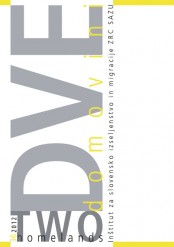An “Indigenous” European Mosque?
Keywords:
tolerance, modern urban society, secularization, multiculturalismAbstract
The attempts to build an Islamic religious and cultural centre (mosque) in Ljubljana have posed a lot of “glocal” theoretical as well as practical questions. Problems in implementing multiculturalism in apparently open, urban, secular societies are usually interpreted as minor temporary troubles, motivated by not yet surmounted resistance to others and otherness. Doubts in this interpretation are expressed in the text by presenting two cases which reveal that building “alien” houses of worship trigger deeply rooted archetypical fears which prove difficult to control using the rather simple (post)modernist regulative repertoire.
Downloads
References
Bellah, Robert Neelly (1967). Civil Religion in America. Journal of the American Academy of Arts and Sciences 96/1, 1–21.
Bercken, Will van den, Jonathan, Sutton (2005). Aesthetics as a Religious Factor in Eastern and Western Christianity. Leuven, Paris, Dudley – MA: Peeters.
Bony, Jean (1983). French Gothic Architecture of the 12th and 13th centuries. Berkeley, Los Angeles, London: University of California Press.
Bruce, Robbins (2011). Enchantment? No, Thank You. The Joy of Secularism (ur. George Lewis). New Jersey: Princeton University Press, 74–95.
Calhoun, Craig, Juergensmeyerl, Mark, Van Antwerpen, Jonathan (2011). Rethinking secularism. Oxford: Oxford University Press.
Campbell, Colin (2007). The Easternization of the West. Boulder, London: Paradigm Publisher.
Huntington, Samuel P. (1997). The Clash of Civilizations and the Remaking of World Order. London: The Free Press.
Latour, Bruno (1993). We Have Never Been Modern. Cambridge, Massachusetts: Harvard University Press.
Linder, Gaillard Inge (2005). The Aesthetics of Contemporary French Catholic Churches: Fortresses of Resistance? Aesthetics as a Religious Factor in Eastern and Western Christianity (ur. Will van den Bercken, Jonathan Sutton). Peeters, Leuven, Paris – MA: Dudley, 225–240.
Locke, John (2010). Dve razpravi o oblasti: Pismo o toleranci. Ljubljana: Krtina.
Luckman, Thomas (1997). Nevidna religija. Ljubljana: Krtina.
Nandy, Ashis (1988). The Politics of Secularization and the Recovery of Religious Tolerance. Alternatives 13/2, 177–94.
Robbins, Bruce (2011). »Enchantment? No, Thank You.« The Joy of Secularism: 11 Essays For How We Live Now (ur. George Levine). Princeton: Princeton University Press, 74–94.
Rotar, Braco (1981). Risarji: učenjaki – ideologije v urbanizmu in arhitekturi. Ljubljana: Delavska enotnost.
Smrke, Marjan (2002). Stare vešče – nova luč: Religijske oblike družbene mimikrije v pogojih drzužbene tranzicije. Teorija in praksa 39/2, 170–181.
Smrke, Marjan (2007). Družbena mimikrija. Ljubljana: Fakulteta za družbene vede.
Smrke, Marjan, Hafner Fink, Mitja (2008). (Ne)religioznost in socialna distanca do izbranih družbenih manjšin v (post)tranzicijski Evropi. Teorija in praksa 45/3–4, 285–300.
Škamperle, Igor (2005). Svetišče kot metonimija kozmosa. Poligrafi , revija za religiologijo,mitologijo in fi lozofi jo 10/38, 143–152.
Šterbenc, Primož (2012). Zahod in muslimanski svet. Ljubljana: FDV.
Taylor, Charles (2007). The Secular Age. Cambridge, Massachusetts: Harward University Press.
Vogrinc, Jože (1994). Neznosnost muezinovega glasu. Časopis za kritiko znanosti 164/165, 199–201.
Downloads
Published
How to Cite
Issue
Section
License

This work is licensed under a Creative Commons Attribution-NonCommercial-NoDerivatives 4.0 International License.
Authors guarantee that the work is their own original creation and does not infringe any statutory or common-law copyright or any proprietary right of any third party. In case of claims by third parties, authors commit their self to defend the interests of the publisher, and shall cover any potential costs.
More in: Submission chapter





